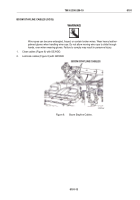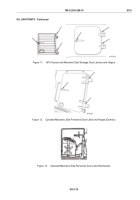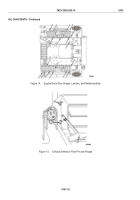TM-9-2350-256-10 - Page 625 of 796
CLEANING PROCEDURES - Continued
WARNING
Eye protection must be worn when cleaning with a wire brush. Flying rust and metal
particles may be hazardous to personnel using wire brush. Failure to comply may result in
personnel injury.
4.
Clean threads on fuel and hydraulic line connectors, using a wire brush. Do not use cleaning solvents.
WARNING
Particles blown by compressed air can be dangerous. Be certain to direct air stream away
from user and other personnel in the area. Compressed air used for cleaning must not
exceed 30 psi (207 kPa). Wear personal protective equipment when working with
compressed air. Failure to comply may result in personnel injury.
5.
Dry parts immediately with compressed air, if available, and apply the appropriate oil to exterior part
surfaces to prevent rusting after steam is used for cleaning. Dry with a clean rag if compressed air is not
available.
6.
External Engine Cleaning.
Cover all electrical equipment and other parts that could be damaged by steam-
cleaning or moisture and cover/plug all openings before cleaning. Dry with compressed air.
7.
Mated Surfaces.
Remove old gasket and/or sealing compound using wire brush and/or cleaning solvent.
8.
Painted Parts.
Parts that appear to be in good condition after cleaning need not be stripped and repainted
in their entirety, but should be cleaned and designated for touch-up only; refer to TM 43-0139 (WP 0131).
Notify maintenance about parts that are rusted or otherwise devoid of paint.
END OF TASK
INSPECTION PROCEDURES
NOTE
Procedures for inspections will be the same for many parts and components which make
up the vehicle subassemblies. General procedures are detailed in the following steps.
Exercise extreme care in all phases of inspection. Notify maintenance if damage is found
during inspection.
1.
Electrical Connectors, Wiring Harnesses, and Leads.
Inspect for chafing, loose, or broken connectors,
wires, or leads.
2.
Expansion Plugs.
Inspect for leakage. Replace plugs when leakage is present.
3.
Externally Exposed Parts.
Inspect for breaks, cracks, rust damage, and wear.
4.
Machined Surfaces.
Inspect for cracks, breaks, elongated holes, wear, and chips.
5.
Machined Tooled Parts.
Inspect for cracks, evidence of wear, galled or pitted surfaces, burrs, nicks, and
scratches.
6.
Mounting Hardware.
Inspect for loose, bent, or missing hardware, stripped threads, and damaged heads.
TM 9-2350-256-10
0102
0102-3
Back to Top




















